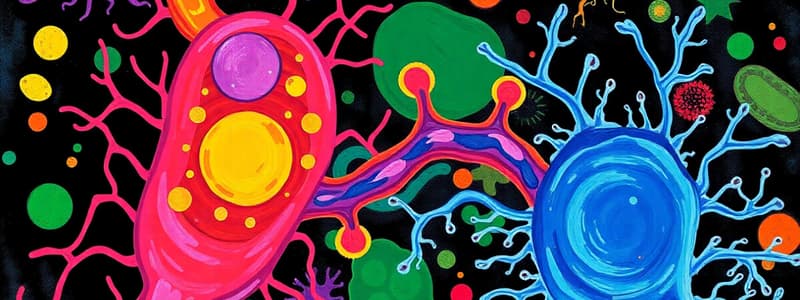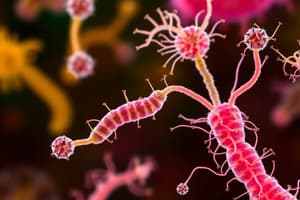Podcast
Questions and Answers
Which term describes an organism without a nucleus?
Which term describes an organism without a nucleus?
- Amphitrichous
- Prokaryotic (correct)
- Biofilm
- Eukaryotic
What is a type of cell that contains a nucleus?
What is a type of cell that contains a nucleus?
- Biofilm
- Eukaryotic (correct)
- Prokaryotic
- Amphitrichous
What is a type of cell that does not contain a nucleus?
What is a type of cell that does not contain a nucleus?
- Eukaryotic
- Biofilm
- Prokaryotic (correct)
- Amphitrichous
What makes up rRNA and rProteins?
What makes up rRNA and rProteins?
What process describes the transfer of genetic information from DNA to RNA?
What process describes the transfer of genetic information from DNA to RNA?
What is the process of creating proteins?
What is the process of creating proteins?
What ensures the passage of genetic information?
What ensures the passage of genetic information?
Which term describes a matrix composed of polysaccharides?
Which term describes a matrix composed of polysaccharides?
What is a component of the cell wall in bacteria?
What is a component of the cell wall in bacteria?
Which structure is a component of the cell wall in fungi and algae?
Which structure is a component of the cell wall in fungi and algae?
Which structure is a component of the cell wall in algae?
Which structure is a component of the cell wall in algae?
What is a way bacteria transfer genetic material to another bacteria?
What is a way bacteria transfer genetic material to another bacteria?
Which of these terms relates to motility?
Which of these terms relates to motility?
What are the protein components of flagellum?
What are the protein components of flagellum?
When are the flagella present in tufts?
When are the flagella present in tufts?
When is a single flagella present at both ends?
When is a single flagella present at both ends?
When are flagella all around the surface?
When are flagella all around the surface?
What describes movement away or towards a stimuli?
What describes movement away or towards a stimuli?
What describes a change of direction in bacterial movement?
What describes a change of direction in bacterial movement?
What is a surface associated community of microorganisms?
What is a surface associated community of microorganisms?
What is the term for cell drinking endocytosis?
What is the term for cell drinking endocytosis?
Which process produces macromolecules?
Which process produces macromolecules?
What process requires no oxygen?
What process requires no oxygen?
What is the process of anaerobic cellular respiration?
What is the process of anaerobic cellular respiration?
What is interference with the enzymatic activity?
What is interference with the enzymatic activity?
What describes inhibition by blocking the active site?
What describes inhibition by blocking the active site?
Flashcards
Prokaryotic
Prokaryotic
An organism without a true nucleus, membrane-bound organelles, or other internal structures.
Eukaryotic
Eukaryotic
An organism with a true nucleus and other membrane-bound organelles.
Transcription
Transcription
A process where DNA's genetic information is copied into RNA.
Translation
Translation
Signup and view all the flashcards
Anabolism
Anabolism
Signup and view all the flashcards
Anaerobic
Anaerobic
Signup and view all the flashcards
Conjugation
Conjugation
Signup and view all the flashcards
Peptidoglycan
Peptidoglycan
Signup and view all the flashcards
Cellulose
Cellulose
Signup and view all the flashcards
Silica
Silica
Signup and view all the flashcards
Flagella
Flagella
Signup and view all the flashcards
Flagellins
Flagellins
Signup and view all the flashcards
Taxis
Taxis
Signup and view all the flashcards
Tumble
Tumble
Signup and view all the flashcards
Motility
Motility
Signup and view all the flashcards
Lophotrichous
Lophotrichous
Signup and view all the flashcards
Amphitrichous
Amphitrichous
Signup and view all the flashcards
Peritrichous
Peritrichous
Signup and view all the flashcards
Biofilm
Biofilm
Signup and view all the flashcards
Glycocalyx
Glycocalyx
Signup and view all the flashcards
Pinocytosis
Pinocytosis
Signup and view all the flashcards
Competitive Inhibition
Competitive Inhibition
Signup and view all the flashcards
Non-competitive Inhibition
Non-competitive Inhibition
Signup and view all the flashcards
Fermentation
Fermentation
Signup and view all the flashcards
Replication
Replication
Signup and view all the flashcards
rRNA
rRNA
Signup and view all the flashcards
Ribosome
Ribosome
Signup and view all the flashcards
Glycoprotein
Glycoprotein
Signup and view all the flashcards
Study Notes
Micro CW L2
- Organisms without a nucleus: Lack a nucleus; prokaryotic
- Organisms with a nucleus: Have a nucleus; eukaryotic
- Formation of rRNA and proteins: Ribosomes are formed from ribosomal RNA (rRNA) and ribosomal proteins
- Genetic information transfer from DNA to RNA: DNA carries the genetic code and is transcribed into RNA, which directs protein synthesis
- Protein synthesis: RNA directs the assembly of amino acids into proteins
- Ensuring genetic information passage: DNA replication ensures accurate duplication of genetic material
- Extracellular matrix composed of polysaccharides: A complex matrix surrounding certain cells or organisms
- Bacterial cell wall component: Peptidoglycan
- Fungal/Algal cell wall component: Varies and can include polysaccharides
- Algal cell wall component: Varies, can include polysaccharides
- Bacterial genetic material transfer: Conjugation, allows direct transfer of DNA
- Motility components: Flagella, facilitates movement
- Flagella presence: Can be in tufts, single at both ends or all around surface
- Bacterial movement direction: Towards or away from stimuli
- Bacterial movement change: Change in direction in response to stimuli
- Microorganism communities: Biofilms/surface associated communities
- Cell drinking: Endocytosis as a means of capturing liquids
- Macromolecule production process: Anabolism
- Oxygen-independent process: Anaerobic respiration
- Enzyme activity interference: Inhibition of cellular processes
- Active site blockage: A type of enzyme inhibition, preventing substrate binding to the active site, inhibiting the enzyme's function
Studying That Suits You
Use AI to generate personalized quizzes and flashcards to suit your learning preferences.





